Lubrication Properties of Bio-Oil and Its Emulsions with Diesel Oil
Abstract
:1. Introduction
2. Experimental
2.1. Bio-Oil
| C | H | N | O | S | Si | Na | K | Ca | Mg | Fe |
|---|---|---|---|---|---|---|---|---|---|---|
| 37.48 | 8.28 | 0.59 | 53.45 | 0.036 | 0.092 | 0.001 | 0.010 | 0.006 | 0.002 | 0.053 |
2.2. Preparation and Characterization of Bio-Oil/Diesel-Oil Emulsions
| Sample | HHV(MJ/kg) | Water (wt%) | Density (g/mL) | Kinematic viscosity (cSt, 313 K) | pH (-) |
|---|---|---|---|---|---|
| BO | 15.4 | 32.3 | 1.13 | 10.2 | 3.2 |
| DO | 44 | - | 0.85 | 2.9 | 7.8 |
| EO10 | 41.9 | 3.3 | 0.88 | 4.9 | 3.4 |
| EO30 | 35.5 | 9.7 | 0.93 | 8.0 | 3.3 |
| EO50 | 29.8 | 16.2 | 0.99 | 15.3 | 3.2 |
2.3. Lubricity Analysis
2.4. Worn and Non-Worn Ball Surface Analysis
2.5. Thermogravimetric Analysis of the Bio-Oil Sample
3. Results and Discussion
3.1. Thermogravimetric Analysis Results
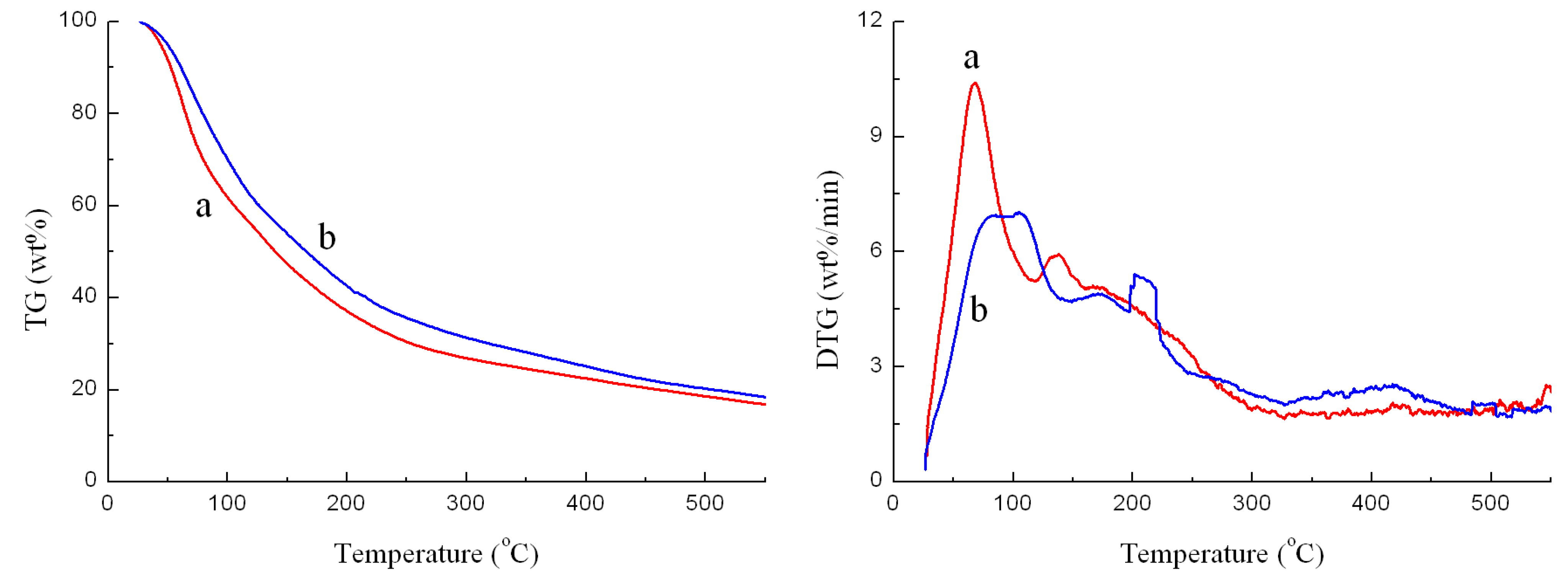
3.2. Lubrication Properties
| Sample | BO | CBO | DO | EO10 | EO30 | EO50 |
|---|---|---|---|---|---|---|
| PB (N) | 470 | 510 | 333 | 470 | 510 | 510 |
| Sample | BO | CBO | DO |
|---|---|---|---|
| WSD (mm) | 0.53 | 0.50 | 0.57 |
| Friction coefficient | 0.057 | 0.034 | 0.108 |
| Sample | BO | EO10 | EO30 | EO50 |
|---|---|---|---|---|
| WSD (mm) | 0.89 | 1.20 | 0.92 | 0.75 |
| Friction coefficient | 0.069 | 0.127 | 0.093 | 0.076 |
3.3. SEM Analysis
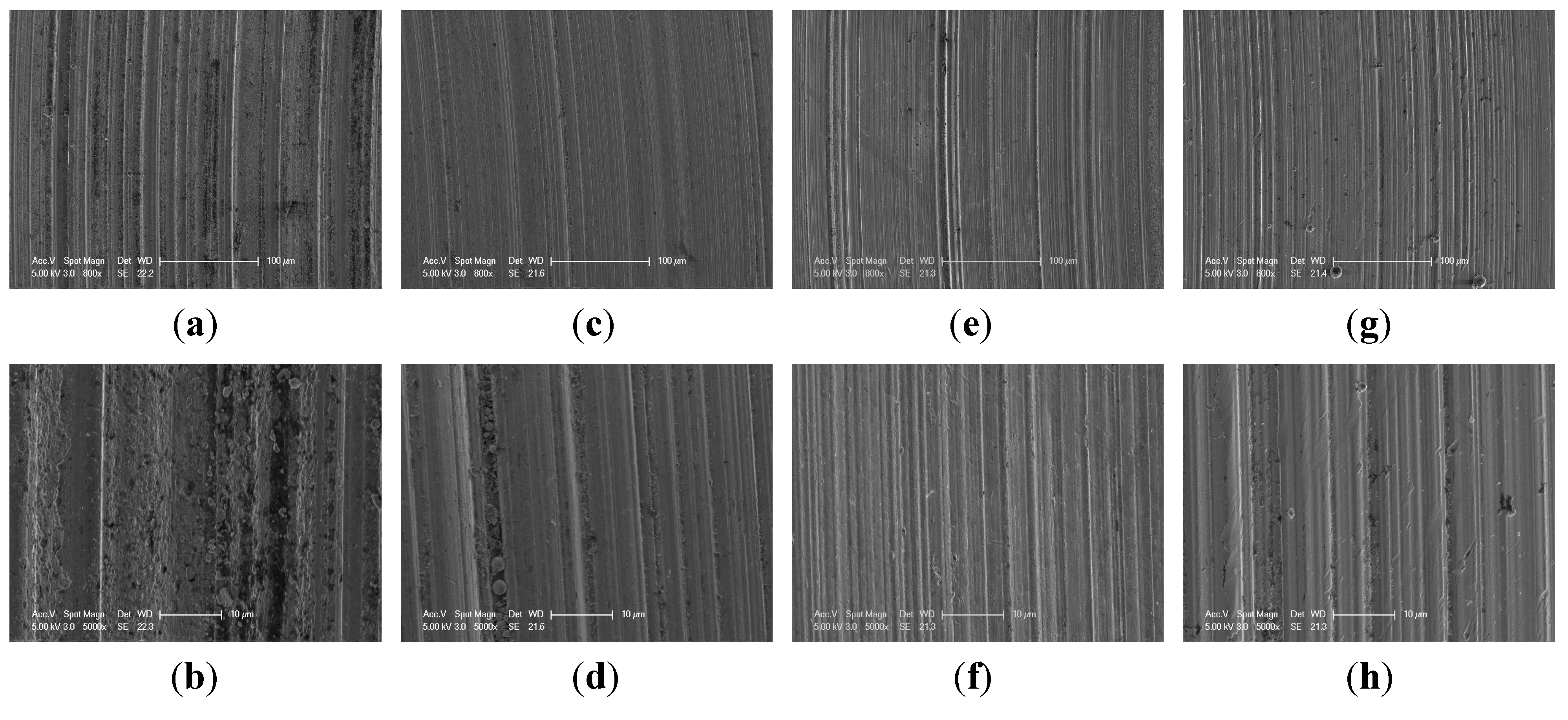
3.4. XPS Analysis


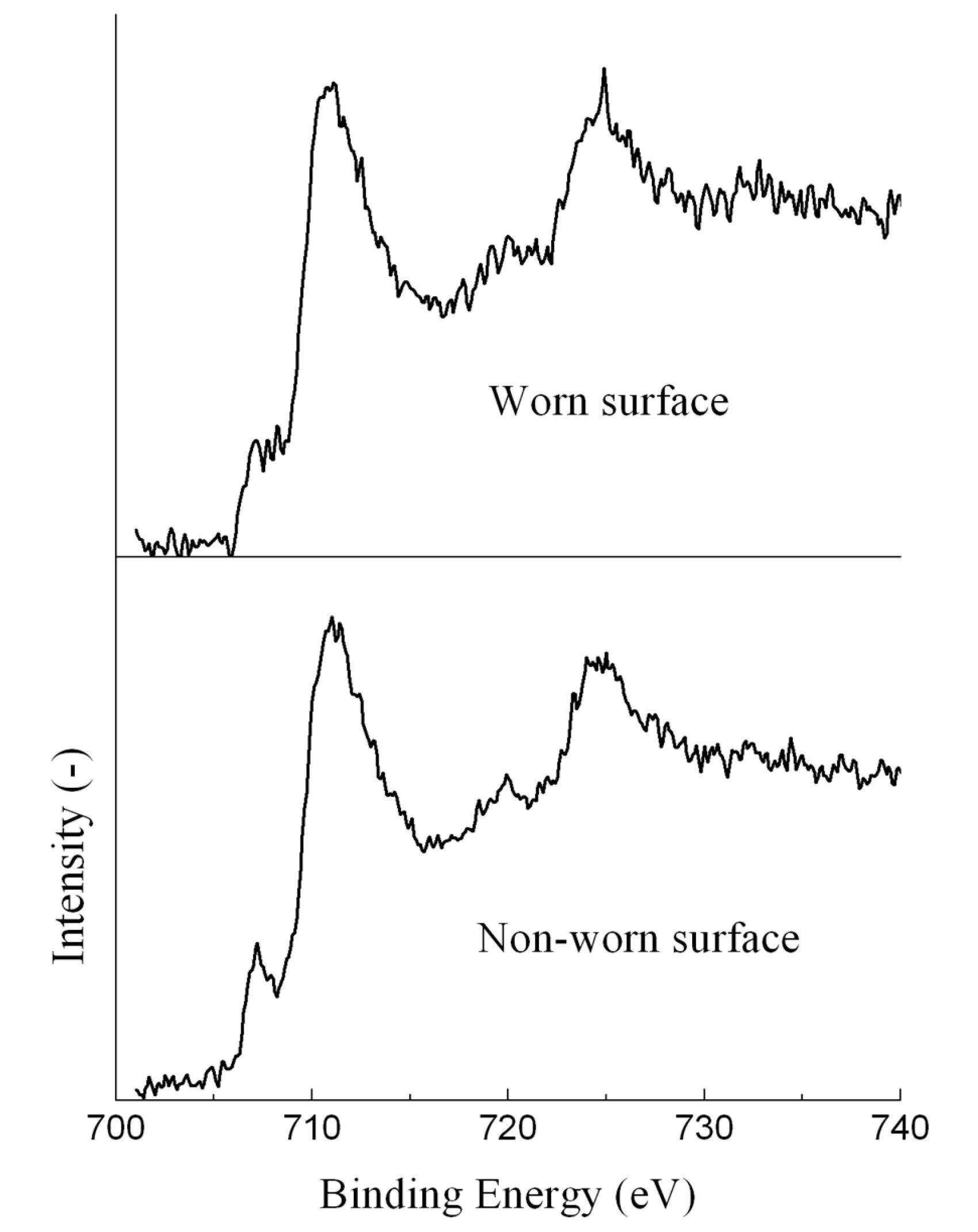
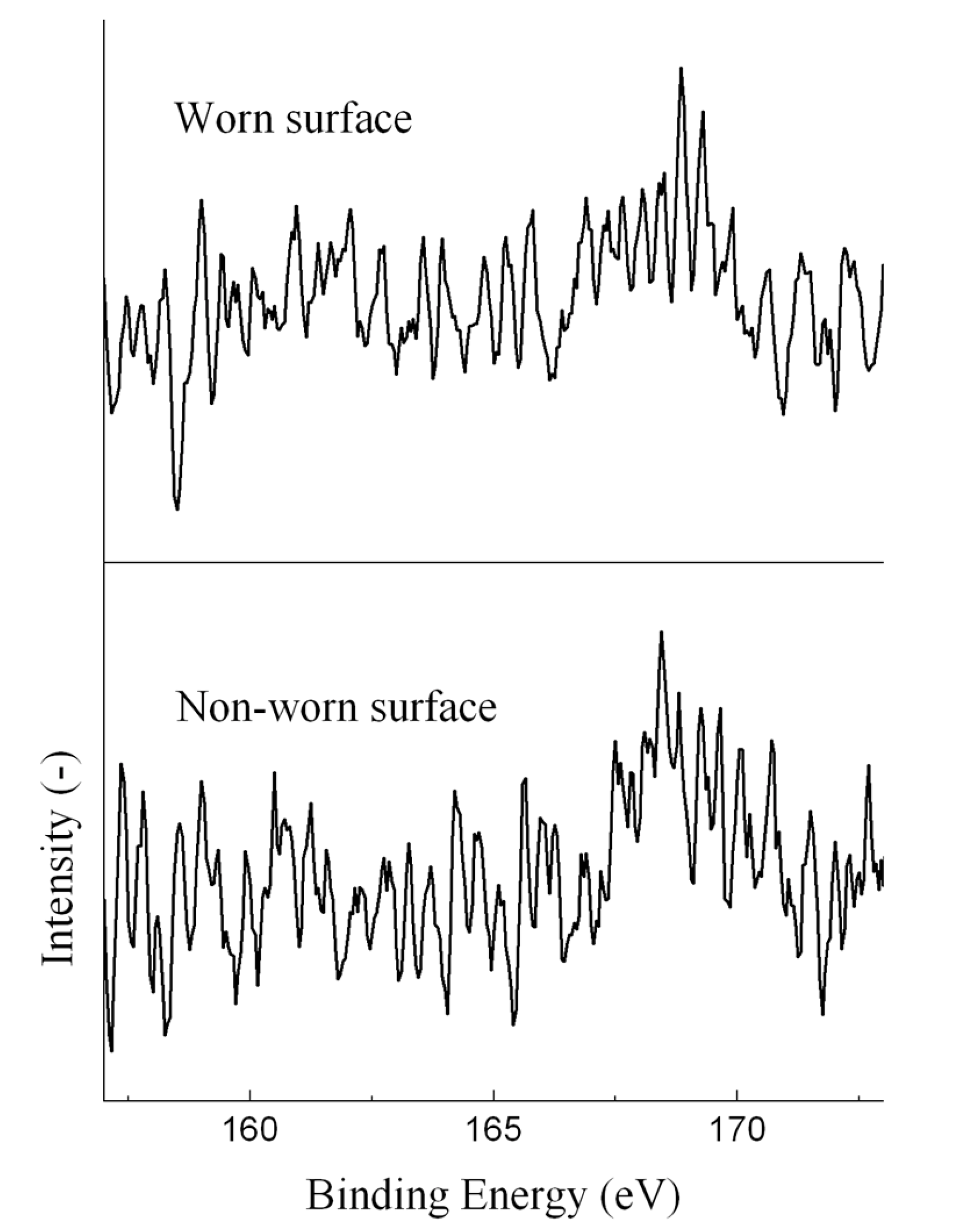
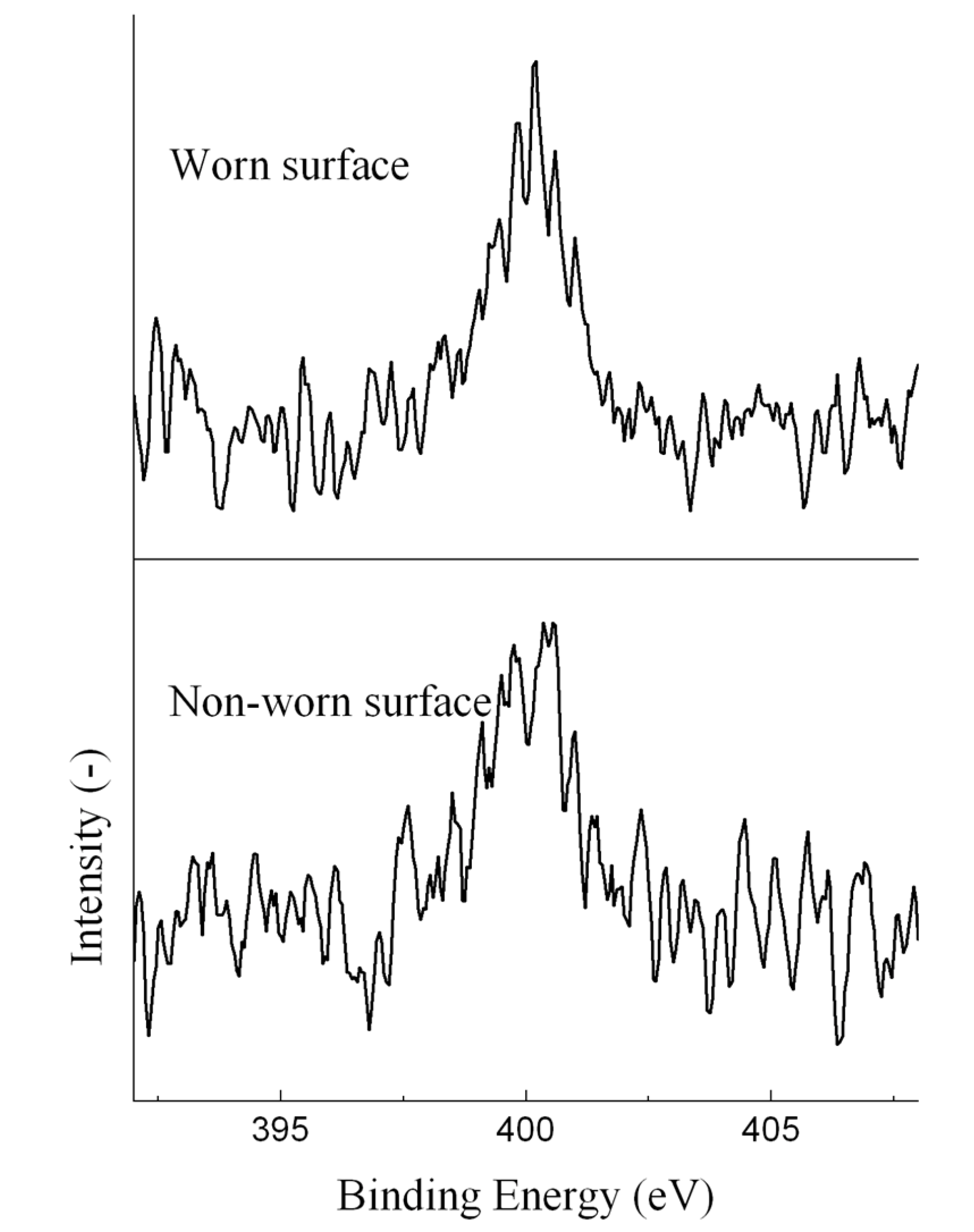
4. Conclusions
Acknowledgments
References
- Bridgwater, A.V.; Peacocke, G.V.C. Fast pyrolysis processes for biomass. Renew. Sustain. Energy Rev. 2000, 4, 1–73. [Google Scholar]
- Mohan, D.; Pittman, C.U.; Steele, P.H. Pyrolysis of wood/biomass for bio-oil: A critical review. Energy Fuels 2006, 20, 848–889. [Google Scholar] [CrossRef]
- Czernik, S.; Bridgwater, A.V. Overview of applications of biomass fast pyrolysis oil. Energy Fuels 2004, 18, 590–598. [Google Scholar] [CrossRef]
- Balat, M. An overview of the properties and applications of biomass pyrolysis oils. Energy Sources Part A 2011, 33, 674–689. [Google Scholar] [CrossRef]
- Lu, Q.A.; Zhang, Z.F.; Dong, C.Q.; Zhu, X.F. Catalytic upgrading of biomass fast pyrolysis vapors with nano metal oxides: An analytical Py-GC/MS study. Energies 2010, 3, 1805–1820. [Google Scholar] [CrossRef]
- Lu, Q.; Li, W.Z.; Zhu, X.F. Overview of fuel properties of biomass fast pyrolysis oils. Energy Convers. Manag. 2009, 50, 1376–1383. [Google Scholar] [CrossRef]
- Chiaramonti, D.; Oasmaa, A.; Solantausta, Y. Power generation using fast pyrolysis liquids from biomass. Renew. Sustain. Energy Rev. 2007, 11, 1056–1086. [Google Scholar] [CrossRef]
- Chiaramonti, D.; Bonini, A.; Fratini, E.; Tondi, G.; Gartner, K.; Bridgwater, A.V.; Grimm, H.P.; Soldaini, I.; Webster, A.; Baglioni, P. Development of emulsions from biomass pyrolysis liquid and diesel and their use in engines—Part 1: emulsion production. Biomass Bioenergy 2003, 25, 85–99. [Google Scholar] [CrossRef]
- Ikura, M.; Stanciulescu, M.; Hogan, E. Emulsification of pyrolysis derived bio-oil in diesel fuel. Biomass Bioenergy 2003, 24, 221–232. [Google Scholar] [CrossRef]
- Garcia-Perez, M.; Adams, T.T.; Goodrum, J.W.; Geller, D.P.; Das, K.C. Production and fuel properties of pine chip Bio-oil/Biodiesel blends. Energy Fuels 2007, 21, 2363–2372. [Google Scholar] [CrossRef]
- Garcia-Perez, M.; Shen, J.; Wang, X.S.; Li, C.Z. Production and fuel properties of fast pyrolysis oil/bio-diesel blends. Fuel Process. Technol. 2010, 91, 296–305. [Google Scholar] [CrossRef]
- Jiang, X.X.; Ellis, N. Upgrading Bio-oil through Emulsification with Biodiesel: Mixture Production. Energy Fuels 2010, 24, 1358–1364. [Google Scholar] [CrossRef]
- Jiang, X.X.; Ellis, N. Upgrading Bio-oil through Emulsification with Biodiesel: Thermal Stability. Energy Fuels 2010, 24, 2699–2706. [Google Scholar] [CrossRef]
- Chiaramonti, D.; Bonini, A.; Fratini, E.; Tondi, G.; Gartner, K.; Bridgwater, A.V.; Grimm, H.P.; Soldaini, I.; Webster, A.; Baglioni, P. Development of emulsions from biomass pyrolysis liquid and diesel and their use in engines—Part 2: tests in diesel engines. Biomass Bioenergy 2003, 25, 101–111. [Google Scholar] [CrossRef]
- Oasmaa, A.; Leppamaki, E.; Koponen, P.; Levander, J.; Tapola, E. Physical characterisation of biomass-based pyrolysis liquids. In Application of Standard Fuel Oil Analyses; VTT Technical Research Centre: Espoo, Finland, 1997; Volume 9. [Google Scholar]
- Xu, Y.F.; Wang, Q.J.; Hu, X.G.; Li, C.; Zhu, X.F. Characterization of the lubricity of bio-oil/diesel fuel blends by high frequency reciprocating test rig. Energy 2010, 35, 283–287. [Google Scholar] [CrossRef]
- Qiang, L.; Xu-Lai, Y.; Xi-Feng, Z. Analysis on chemical and physical properties of bio-oil pyrolyzed from rice husk. J. Anal. Appl. Pyrolysis 2008, 82, 191–198. [Google Scholar] [CrossRef]
- Oasmaa, A.; Czernik, S. Fuel oil quality of biomass pyrolysis oils-State of the art for the end user. Energy Fuels 1999, 13, 914–921. [Google Scholar] [CrossRef]
- Hoekstra, E.; Hogendoorn, K.J.A.; Wang, X.Q.; Westerhof, R.J.M.; Kersten, S.R.A.; van Swaaij, W.P.M.; Groeneveld, M.J. Fast pyrolysis of biomass in a fluidized bed reactor: In situ filtering of the vapors. Ind. Eng. Chem. Res. 2009, 48, 4744–4756. [Google Scholar] [CrossRef]
- Chen, T.; Wu, C.; Liu, R.; Fei, W.; Liu, S. Effect of hot vapor filtration on the characterization of bio-oil from rice husks with fast pyrolysis in a fluidized-bed reactor. Bioresour. Technol. 2011, 102, 6178–6185. [Google Scholar] [CrossRef] [PubMed]
- Darmstadt, H.; Garcia-Perez, M.; Adnot, A.; Chaala, A.; Kretschmer, D.; Roy, C. Corrosion of metals by bio-oil obtained by vacuum pyrolysis of softwood bark residues. An X-ray photoelectron spectroscopy and auger electron spectroscopy study. Energy Fuels 2004, 18, 1291–1301. [Google Scholar] [CrossRef]
- Hua, W.; Jing, L.; Hongling, Y.; Xiangqiong, Z.; Lingbo, L.; Tianhui, R. The tribological behavior of diester-containing polysulfides as additives in mineral oil. Tribol. Int. 2007, 40, 1246–1252. [Google Scholar] [CrossRef]
© 2012 by the authors; licensee MDPI, Basel, Switzerland. This article is an open access article distributed under the terms and conditions of the Creative Commons Attribution license (http://creativecommons.org/licenses/by/3.0/).
Share and Cite
Lu, Q.; Zhang, Z.-B.; Liao, H.-T.; Yang, X.-C.; Dong, C.-Q. Lubrication Properties of Bio-Oil and Its Emulsions with Diesel Oil. Energies 2012, 5, 741-751. https://doi.org/10.3390/en5030741
Lu Q, Zhang Z-B, Liao H-T, Yang X-C, Dong C-Q. Lubrication Properties of Bio-Oil and Its Emulsions with Diesel Oil. Energies. 2012; 5(3):741-751. https://doi.org/10.3390/en5030741
Chicago/Turabian StyleLu, Qiang, Zhi-Bo Zhang, Hang-Tao Liao, Xiao-Chu Yang, and Chang-Qing Dong. 2012. "Lubrication Properties of Bio-Oil and Its Emulsions with Diesel Oil" Energies 5, no. 3: 741-751. https://doi.org/10.3390/en5030741
APA StyleLu, Q., Zhang, Z.-B., Liao, H.-T., Yang, X.-C., & Dong, C.-Q. (2012). Lubrication Properties of Bio-Oil and Its Emulsions with Diesel Oil. Energies, 5(3), 741-751. https://doi.org/10.3390/en5030741





